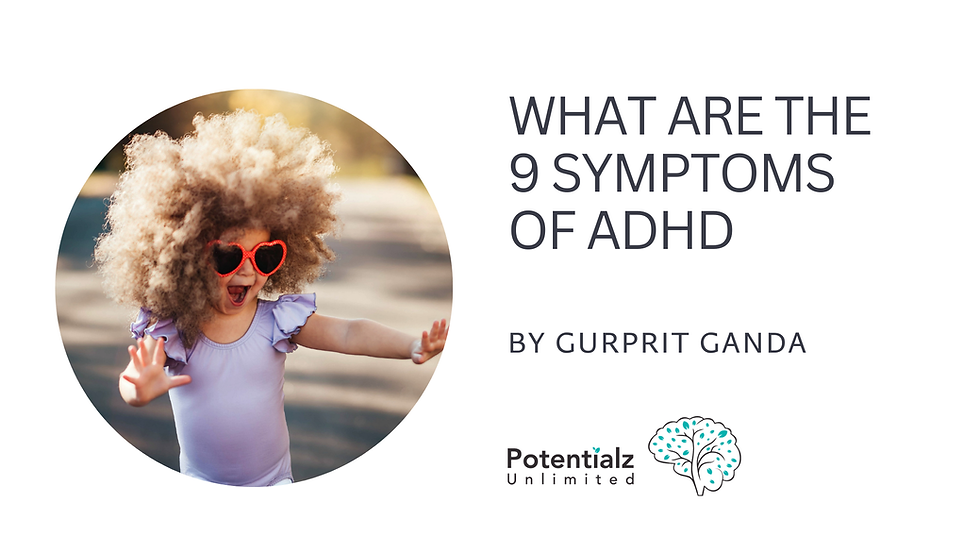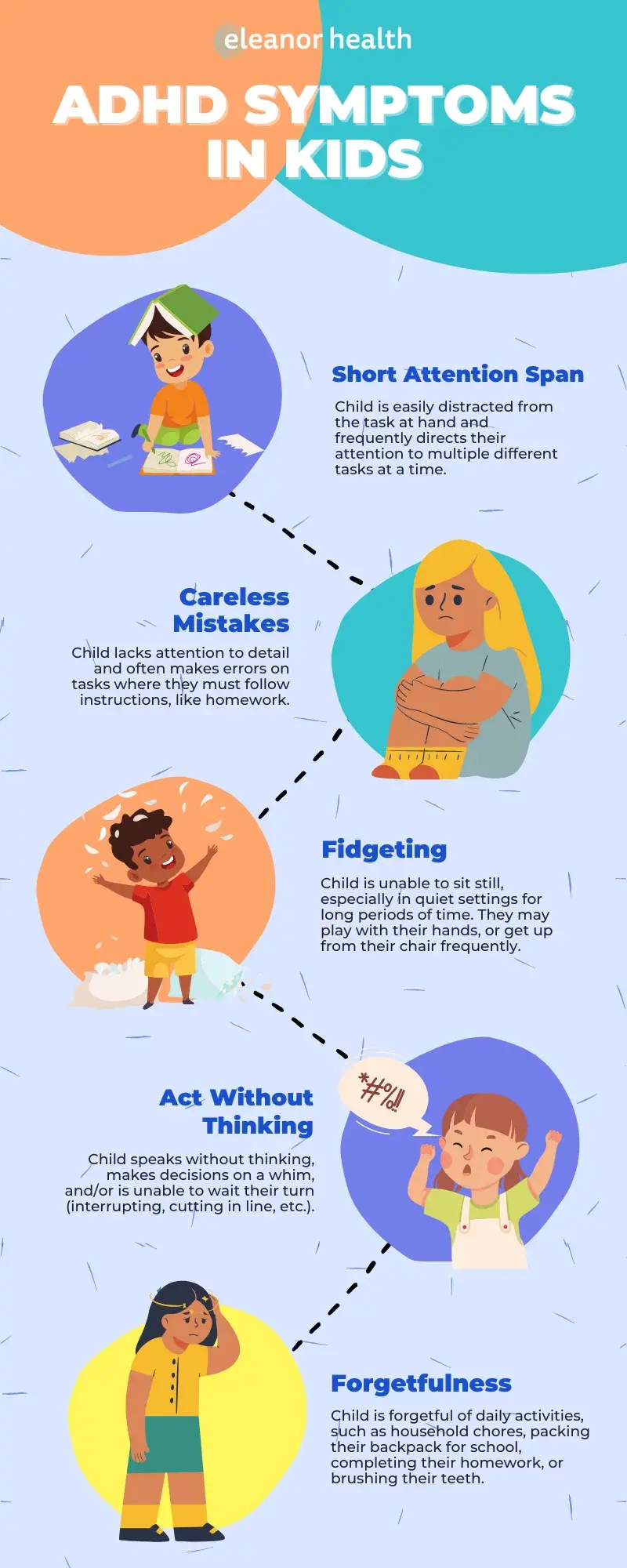
Attention Deficit Hyperactivity Disorder (ADHD) is a neurodevelopmental disorder that affects both children and adults. Understanding the symptoms of ADHD is crucial for an accurate diagnosis and effective management. In this blog post, we will explore the nine key symptoms associated with ADHD, helping you to identify potential signs in yourself or your loved ones.
Understanding ADHD
ADHD is characterised by persistent patterns of inattention, hyperactivity, and impulsivity that interfere with functioning or development. The symptoms can vary widely from one individual to another, making it essential to consider a comprehensive evaluation for an accurate ADHD diagnosis. According to the Diagnostic and Statistical Manual of Mental Disorders (DSM-5), ADHD affects approximately 5% of children and 2.5% of adults globally (American Psychiatric Association, 2013).


The Nine Symptoms of ADHD
1. Inattention
One of the hallmark symptoms of ADHD is inattention. Individuals may struggle to focus on tasks, leading to careless mistakes in schoolwork or other activities. They may find it challenging to follow through on instructions and often fail to complete assignments or chores. Research has shown that inattention symptoms can persist into adulthood and significantly impact daily functioning (Faraone et al., 2015).
2. Difficulty Organising Tasks
People with ADHD frequently have trouble organising tasks and activities. This can manifest as difficulty keeping track of belongings, managing time effectively, or prioritising responsibilities. As a result, they may feel overwhelmed by daily tasks and deadlines. A study by Sibley et al. (2012) found that organizational difficulties were strongly associated with academic impairment in adolescents with ADHD.

3. Forgetfulness
Forgetfulness is another common symptom associated with ADHD. Individuals may forget appointments, deadlines, or important dates regularly. This symptom can lead to frustration for both the individual and those around them as it can impact personal relationships and work performance. A meta-analysis by Alderson et al. (2013) demonstrated that individuals with ADHD consistently show deficits in working memory, which contributes to forgetfulness.
4. Fidgeting
Hyperactivity often presents itself through fidgeting or restlessness. Children might be seen tapping their feet or playing with objects when they should be sitting still. Adults may find themselves unable to relax in situations where they are expected to remain calm. Fidgeting has been linked to cognitive performance in individuals with ADHD, with some studies suggesting it may serve as a compensatory mechanism for attention regulation (Hartanto et al., 2016).
5. Impulsivity
Impulsivity is a significant symptom of ADHD that can lead individuals to act without considering the consequences. This might include interrupting conversations, blurting out answers before questions are completed, or making hasty decisions without weighing options carefully. Research by Nigg et al. (2005) has shown that impulsivity in ADHD is associated with deficits in response inhibition and decision-making processes.
6. Difficulty Sustaining Attention
Individuals with ADHD often struggle to maintain attention during tasks that require prolonged mental effort—such as reading long texts or listening during lectures. This difficulty can hinder academic performance and workplace productivity. A study by Tucha et al. (2017) found that adults with ADHD showed significant impairments in sustained attention compared to non-ADHD controls.
7. Easily Distracted
Another common symptom is being easily distracted by extraneous stimuli—such as noises in the environment—or even unrelated thoughts that interrupt focus on the task at hand. This distraction can make it challenging for individuals with ADHD to complete tasks efficiently. Research by Forster et al. (2014) has demonstrated that individuals with ADHD show increased susceptibility to distraction, particularly in the presence of task-irrelevant stimuli.
8. Trouble Following Through on Tasks
Many people with ADHD find it hard to follow through on tasks once they begin them; this could mean starting multiple projects but failing to finish any of them fully due to losing interest or becoming sidetracked by other activities. A longitudinal study by Langberg et al. (2013) found that difficulties with task completion in adolescence predicted academic impairment in young adulthood for individuals with ADHD.
9. Emotional Dysregulation
Emotional dysregulation refers to difficulties managing emotions effectively; individuals may experience intense emotional responses that seem disproportionate compared to the situation at hand—leading them into conflicts at home, school, or work settings. Recent research has highlighted the importance of emotional dysregulation in ADHD, with some suggesting it should be considered a core feature of the disorder (Shaw et al., 2014).
Seeking an Accurate Diagnosis
If you recognise these symptoms in yourself or someone else, seeking an ADHD diagnosis from a qualified professional is essential for proper management strategies tailored specifically for each individual's needs. The diagnostic process typically involves:
Clinical Interviews: Gathering comprehensive information about behaviour patterns from parents/teachers (for children) alongside self-reports.
Standardised Rating Scales: Utilising questionnaires designed specifically for assessing attention deficits/hyperactivity.
Observations: Observing behaviours across different settings (home/school/work) helps provide context regarding how symptoms manifest.
It's important to note that a diagnosis of ADHD requires the presence of several symptoms that persist for at least six months and occur in multiple settings (American Psychiatric Association, 2013).
Treatment and Management
Once diagnosed, various treatment options are available for managing ADHD symptoms:
Medication: Stimulant medications like methylphenidate and amphetamines are often prescribed and have shown effectiveness in reducing core ADHD symptoms (Cortese et al., 2018).
Behavioral Therapy: Cognitive-behavioral therapy (CBT) and other behavioral interventions can help individuals develop coping strategies and improve organizational skills (Knouse et al., 2017).
Educational Support: For children with ADHD, accommodations in the classroom and specialized educational plans can significantly improve academic performance (DuPaul et al., 2011).
Lifestyle Modifications: Regular exercise, adequate sleep, and a balanced diet have been shown to have positive effects on ADHD symptoms (Cerrillo-Urbina et al., 2015).
Conclusion
Recognising these nine symptoms of ADHD can help guide conversations about seeking an ADHD diagnosis if necessary; early intervention plays a crucial role in improving outcomes for individuals living with this condition. If you suspect you have undiagnosed attention issues affecting your daily life significantly—consider reaching out to a healthcare professional today!
Understanding these signs not only aids personal awareness but also fosters empathy towards those who navigate life while managing their unique challenges associated with Attention Deficit Hyperactivity Disorder (ADHD). By increasing awareness and understanding of ADHD symptoms, we can work towards creating more supportive environments for individuals with ADHD across all aspects of life.
References
Alderson, R. M., Kasper, L. J., Hudec, K. L., & Patros, C. H. (2013). Attention-deficit/hyperactivity disorder (ADHD) and working memory in adults: A meta-analytic review. Neuropsychology, 27(3), 287-302. https://doi.org/10.1037/a0032371
American Psychiatric Association. (2013). Diagnostic and statistical manual of mental disorders (5th ed.). https://doi.org/10.1176/appi.books.9780890425596
Cerrillo-Urbina, A. J., García-Hermoso, A., Sánchez-López, M., Pardo-Guijarro, M. J., Santos Gómez, J. L., & Martínez-Vizcaíno, V. (2015). The effects of physical exercise in children with attention deficit hyperactivity disorder: A systematic review and meta-analysis of randomized control trials. Child: Care, Health and Development, 41(6), 779-788. https://doi.org/10.1111/cch.12255
Cortese, S., Adamo, N., Del Giovane, C., Mohr-Jensen, C., Hayes, A. J., Carucci, S., ... & Cipriani, A. (2018). Comparative efficacy and tolerability of medications for attention-deficit hyperactivity disorder in children, adolescents, and adults: A systematic review and network meta-analysis. The Lancet Psychiatry, 5(9), 727-738. https://doi.org/10.1016/S2215-0366(18)30269-4
DuPaul, G. J., Weyandt, L. L., & Janusis, G. M. (2011). ADHD in the classroom: Effective intervention strategies. Theory Into Practice, 50(1), 35-42. https://doi.org/10.1080/00405841.2011.534935
Faraone, S. V., Asherson, P., Banaschewski, T., Biederman, J., Buitelaar, J. K., Ramos-Quiroga, J. A., ... & Franke, B. (2015). Attention-deficit/hyperactivity disorder. Nature Reviews Disease Primers, 1(1), 1-23. https://doi.org/10.1038/nrdp.2015.20
Forster, S., Robertson, D. J., Jennings, A., Asherson, P., & Lavie, N. (2014). Plugging the attention deficit: Perceptual load counters increased distraction in ADHD. Neuropsychology, 28(1), 91-97. https://doi.org/10.1037/neu0000020
Hartanto, T. A., Krafft, C. E., Iosif, A. M., & Schweitzer, J. B. (2016). A trial-by-trial analysis reveals more intense physical activity is associated with better cognitive control performance in attention-deficit/hyperactivity disorder. Child neuropsychology : a journal on normal and abnormal development in childhood and adolescence, 22(5), 618–626. https://doi.org/10.1080/09297049.2015.1044511
Knouse, L. E., Teller, J., & Brooks, M. A. (2017). Meta-analysis of cognitive-behavioral treatments for adult ADHD. Journal of consulting and clinical psychology, 85(7), 737–750. https://doi.org/10.1037/ccp0000216
Nigg, J. T., Stavro, G., Ettenhofer, M., Hambrick, D. Z., Miller, T., & Henderson, J. M. (2005). Executive functions and ADHD in adults: evidence for selective effects on ADHD symptom domains. Journal of abnormal psychology, 114(4), 706–717. https://doi.org/10.1037/0021-843X.114.3.706
Sibley, M. H., Altszuler, A. R., Morrow, A. S., & Merrill, B. M. (2014). Mapping the academic problem behaviors of adolescents with ADHD. School psychology quarterly : the official journal of the Division of School Psychology, American Psychological Association, 29(4), 422–437. https://doi.org/10.1037/spq0000071
Shaw, P., Stringaris, A., Nigg, J., & Leibenluft, E. (2014). Emotion dysregulation in attention deficit hyperactivity disorder. The American journal of psychiatry, 171(3), 276–293. https://doi.org/10.1176/appi.ajp.2013.13070966
Tucha, L., Fuermaier, A. B., Koerts, J., Buggenthin, R., Aschenbrenner, S., Weisbrod, M., Thome, J., Lange, K. W., & Tucha, O. (2017). Sustained attention in adult ADHD: time-on-task effects of various measures of attention. Journal of neural transmission (Vienna, Austria : 1996), 124(Suppl 1), 39–53. https://doi.org/10.1007/s00702-015-1426-0

Comments